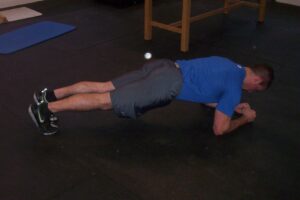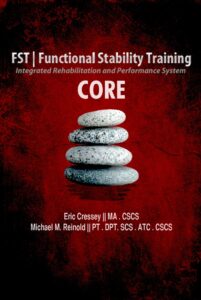by Eric Cressey
In part 1 of this series, I discussed an overall approach to the categorization of core stability exercises. Here, in the second installment of this series, I'll be talking about how to incorporate various core stability exercises into your strength and conditioning programs.
To recap, the categories we'll be dealing with are anterior core, posterior core, lateral core, and rotary core. In reality, though, in my eyes, we only really need to specifically program for three of these categories. You see, the posterior core seems to take care of itself, as we are already training the ability to resist flexion with various strength exercises like deadlifts, squats, pull-throughs, kettlebell swings, and a host of other strength. Some folks may benefit from some birddogs in the warm-up period to help learn the anti-flexion patterning a bit better, but most folks are ready to rock and roll with a comprehensive strength and conditioning program that emphasizes the other three.
With that "exception" out of the way, I think it's important to appreciate three different factors when programming core stability exercises:
1. An individual's training experience – A true beginner can typically work on low-level core exercises like dead bugs and prone and side bridges on a daily basis to establish motor control. Conversely, these exercises may be too basic for a more advanced lifter, so he/she would need to focus on more advanced exercises, but do them less frequently (1-3x/week).
2. An individual's weaknesses – A young athlete with a raging anterior pelvic tilt would need to prioritize anti-extension core stability exercises over the other categories, as you want to master the sagittal plane before getting "too sexy" in other planes. Sure, you can train the other ones, but you're better off working on the most pressing issue first.
3. An individual's training frequency – Obviously, if someone is training 4-6x/week, you can do more in terms of core stability exercises with his strength and conditioning programs than you could if he was only training 2x/week. When they train less frequently, you often have to make some sacrifices in terms of core stability exercise volume in order to make sure the big-bang strength exercises (which can serve as indirect core training exercises) still get the attention they deserve.
With these three factors in mind, let's look at a few examples. Keep in mind that in each of these examples, I've removed the compound exercises, mobility drills, foam rolling, and metabolic conditioning just so that you can see how the core training exercises exist in isolation.
Example 1: 4x/week Strength and Conditioning Program
Day 1: Challenging Anterior Core (e.g., Rollouts), Low-Level Lateral Core (e.g., Side Bridges)
Day 2: Challenging Rotary Core (e.g., Landmines), Low-Level Anterior Core (e.g., Naked Get-ups)
Day 3: Challenging Anterior Core (e.g., ), Low-Level Rotary Core (e.g., Pallof Presses)
Day 4: Challenging Lateral Core (e.g., 1-arm Carries), Low-Level Anterior Core (e.g., Reverse Crunches)
Day 2: Challenging Rotary Core (e.g., Landmines), Low-Level Anterior Core (e.g., Naked Get-ups)
Day 3: Challenging Anterior Core (e.g., ), Low-Level Rotary Core (e.g., Pallof Presses)
Day 4: Challenging Lateral Core (e.g., 1-arm Carries), Low-Level Anterior Core (e.g., Reverse Crunches)
Here, you have all the flexibility in the work to prioritize the areas that are lagging the most. This example emphasized anterior core, but it could have easily been lateral or rotary core stability with some quick and easy substitutions.
Example 2: 3x/week Strength and Conditioning Program
Day 1: Challenging Anterior Core (e.g., Rollouts), Low-Level Lateral Core (e.g., Side Bridges)
Day 2: Challenging Rotary Core (e.g., Landmines), Low-Level Anterior Core (e.g., Reverse Crunches)
Day 3: Challenging Lateral Core (e.g., 1-arm Carries), Low-Level Rotary Core (e.g., Pallof Presses)
Day 2: Challenging Rotary Core (e.g., Landmines), Low-Level Anterior Core (e.g., Reverse Crunches)
Day 3: Challenging Lateral Core (e.g., 1-arm Carries), Low-Level Rotary Core (e.g., Pallof Presses)
You can still get in two versions of each of the "big three" core stability exercise categories over the course of the week – and that doesn't even include the "accidental" benefits you get from your compound strength exercises.
Example 3: 2x/week Strength and Conditioning Program
Day 1: Lateral Core (e.g., 1-arm Carries), Anterior Core from loaded push-up variation
Day 2: Rotary Core (e.g., Split-Stance Cable Lift), Anterior Core from overhead pressing.
You can see that this is far from "optimal" in terms of covering everything you want to cover in a comprehensive core stability exercise program, but when you can only get in two sessions a week (as might be the case for an in-season athlete), you make sacrifices and do what you can. This athlete might be able to complement this program with some low-level prone bridges, reverse crunches, and get-up variations on off-days.
Hopefully, this gives you a little glimpse into what a few sample weeks of core stability exercises look like in Cressey Performance strength training programs. For more information and another perspective, I'd encourage you to check out our Functional Stability Training of the Core resource, which is on sale for 20% off this week with the coupon code BLACKFRIDAY2013. Click here to learn more.


Комментариев нет:
Отправить комментарий